

The High Country Xeriscape Council of Arizona is a non-profit 501 (c) (3) corporation dedicated to educating our communities about water-wise gardening. For additional information write:
HCXCA
4397 E AZ Highway 260
Payson, AZ 85541
GOOD GARDENING by Barb Bourscheidt - Roundup contributor, President of the Xeriscape Council, and avid gardener.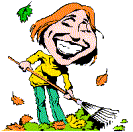
Season is here for bare-root planting
Knee-deep in seed catalogs
Water-wise gardening in the rim country
August in the rim country garden
Low care, no care grasses - a water-wise alternative
Xeriscape A water-wise alternative
Plant selection, placement key to water-wise landscaping
Consider a living Christmas tree this year
Water saving strategies
Creating your water-wise garden
The wildflower garden
Forewarned is forearmed
Spring might promise good monsoon
Keeping poinsettia alive past christmas
Season is here for bare-root planting
Gazing outdoors at wonderful, white, wet snow, the avid gardener's thoughts drift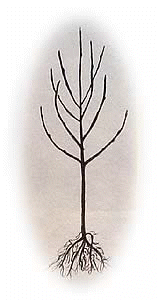 to the start of the gardening year. Although February can be the coldest month in the Rim country, it can also be one of the most productive and rewarding.
to the start of the gardening year. Although February can be the coldest month in the Rim country, it can also be one of the most productive and rewarding.
The nurseries are beginning to receive regular shipments of bare-root trees and shrubs, and there is a good selection available. Planting bare-root stock is an economical and efficient way to add high quality plants to the garden, as there is a large variety of trees, shrubs, berries and vines that may not be available in other forms later on. Before purchase, try and do a little research as to which varieties are best suited to our erratic climate conditions.
There are many advantages to bare-root planting. First, roots do not go dormant, as do stems and buds. Throughout the winter, when temperatures are above freezing and there is enough available moisture, roots grow and store energy, so when the growing season begins, the plant has enough energy to send out buds, leaves, and set fruit.
Next, because the roots are exposed, the health and condition of the roots and crown of the plant can be inspected. Choose plants with roots that are supple, branched, alive and free of insects and disease. Avoid plants with one-sided, girdling or tightly encircling roots, which indicates the plant has been pot bound. Other conditions to watch for are dehydrated or frozen roots, which are brittle, or mushy roots that are rotten and give off an unpleasant odor. Plants with mold on the roots, the crown or the graft site should also be rejected.
Proper care for the bare-root plant between bringing it home and planting is extremely important. The roots should be kept moist but not soggy, cool but not allowed to freeze. Store plants in a cool shed or garage or under the eaves on the north side of the building.
Some plants, such as roses or berries may be packaged in plastic with moist mulch around the roots. Leave plants in packaging, but store in a cold location without sun shining on the packaging. Sun can cause condensation inside the package and promote mold growth.
Soak the roots in a large bucket in cold water for a few hours, but not longer than overnight, before planting. Prepare the planting hole based on the type and size of the plant going into it. Wait until the ground is not soggy to dig planting holes, as the soil should be crumbly. Otherwise, the sides of the hole can become burnished by the blade of the shovel, may harden, and not allow the roots to spread as they grow.
Dig or till an area a foot or so deep around the spot where the hole will be dug, and work in several inches of composted organic material. As the planting hole is dug, some of this organic material will blend into the soil, and make a healthy transitional area for the roots to spread into. Just filling the planting hole with organic material is counterproductive because once the roots hit the wall of the hole and have to make the transition into native soil, they may stop growing and the plant may become stunted or die.
Be sure to choose a planting area that drains well. Drainage is a prime factor in growing a healthy plant, except for bog and water plants.
Specimens without a taproot should go into a hole that is just deep enough to accommodate the root system, with a firmly tamped cone of soil to set the plant on, and drape the roots over. Plants with a taproot need a hole deep enough to accommodate the tap. Both types should be planted just deeply enough to hold the roots firmly in the ground.
Look for the soil mark left on the plant from when it was dug by the grower. When planting, backfill the soil over the roots, tamp it firmly, but do not compress, and water it well. Inspect the plant and make sure the crown is still above grade, or water will accumulate around it and can cause rotting. Spread a thick layer of mulch over the entire planting site but not touching the trunk or stems of the plant. 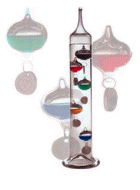 Monitor the weather and precipitation amounts, and every two weeks or so, test the soil for moisture. A large screwdriver inserted into the soil should easily penetrate 10 to 12 inches. If it does not, give the bare-root transplant a long, slow watering during the day.
Monitor the weather and precipitation amounts, and every two weeks or so, test the soil for moisture. A large screwdriver inserted into the soil should easily penetrate 10 to 12 inches. If it does not, give the bare-root transplant a long, slow watering during the day.
In-between cold spells, garden maintenance chores this month include pruning of all dormant fruit and ornamentals. Use "Hi-Yield" dormant oil spray on deciduous fruits and ornamentals to kill over-wintering insect eggs and disease spores. Pull large weeds as the ground is soft, and the root system should be easily removed. Remove heavy snow with a rake or broom to prevent branches from breaking.
Supply water for birds. Suet, fruit and seed will also be gobbled hungrily. Attracting birds to home gardens helps keep insect populations in check, and the ecosystem in balance.
Knee-Deep in Seed Catalogs ![]()
Most gardeners cherish the chilly, dark days of January. Those days bring with them the chance to sit by the fire and devour the delicious pictures and descriptions contained within the pages of seed catalogs arriving daily by mail. 
Unfortunately, most seed and plant catalogs originate in places with climates and soils much different than the Rim country. Terms such as "easy to grow" or "ready self-seeder" might well describe a flowering plant that flourishes in the Midwest, but could be a great disappointment in the high desert.
Fortunately, growers who specialize in southwest arid land plants are beginning to appear, and by following their shipping and planting date advice, Rim country gardeners can enjoy growing plants best suited to this area.
High Country Gardens in Santa Fe, (www.highcountrygardens.com) 800-925-9387 and Plants of the Southwest, (www.plantsofthesouthwest.com) 800-788-7333 are two reliable sources to contact for catalogs. Western Native Seed (www.westernnativeseed.com or 719-942-3935) which specializes in native plant seeds for the Rocky Mountains and Western Plains has an exceptional website, and also a print catalog.
For vegetable seeds, Territorial Seed Company (www.territorialseed.com or 541-942-9547) is an excellent source of seeds of flowers, herbs, and vegetables that do well in our hot day, cold night climate of summer.
Contact Wildseed Farms  (www.wildseedfarms.com or 800-848-0078). For wildflower seeds and comprehensive information on how to grow them, their catalog is an extremely useful resource on what seedlings look like.
(www.wildseedfarms.com or 800-848-0078). For wildflower seeds and comprehensive information on how to grow them, their catalog is an extremely useful resource on what seedlings look like.
Once in awhile, January brings 60 degree sunshine, just about perfect for a little digging, and the best time of the year to transplant small natives. Little trees and shrubs that have popped up in undesirable spots can be used to better advantage elsewhere. Oak, juniper, pine, manzanita, and other native shrubs can be dug and replanted with a little care. The ground must be moist, and not frozen. Dig the new hole before removing the plant from it's growing spot. A good rule of thumb for hole size would be 6 inches beyond the drip line of the tree or shrub.
Most shrubs are shallower rooted than trees, which can have a root as long as the tree is tall. Once the transplant hole is dug, gently dig out the plant to be moved, carefully place it in the new hole, and tamp soil firmly around the roots.
Some plants are fussy about the direction they face, so tagging the plant on the north side, and resetting it facing that direction is beneficial. Transplants need regular moisture to establish their roots, taking care to allow the top 4- inches of soil to dry out between watering. Mulching with the same sort of material found on the surface where the plant was growing previously also helps.
Native plants may be available in containers at a local nursery, and if planted now will get a head start on establishing their roots before the growing season begins. Apache plume, cliff rose, manzanita, nolina, yucca, agave, big leaf sage, rabbit brush and other deciduous shrubs will be better off in the ground than in plastic pots.
A visit to the low-water use demonstration garden at the Gila Community College Campus will offer ideas on how to use natives and other low water use plants in a landscape.
Other Garden Chores
MULCH: Mix some manure with straw or oak leaves and pine needles or wood chips and spread around the base of trees, shrubs and perennials. Winter rain and snow will break down these materials and feed the soil, while the bulk will protect roots from freezing and will hold in moisture.
WATER: Keep a garden journal and when Mother Nature has not provided rain or snow for 3 weeks, start checking soil moisture. When top three or four inches of soil are dry, use a soaker hose at mid-day to water trees and shrubs. Buy a moisture meter and rain gauge to gain accuracy as to how much water is really necessary.
PLANT: Visit a nursery and look at low water-use plants with good "bones" to provide winter interest. If now is not the time to plant those selected, enter their names in a garden journal, for later reference.
Water-Wise Gardening in the Rim Country ![]()
There is a change occurring in the thinking of gardeners all over the country regarding the type and style of plants chosen for the home and business garden. Americans are choosing to make their gardens more congruent with the environment in which they live by focusing on the use of plants that thrive on natural precipitation, and landscape styles, which blend into the surrounding countryside.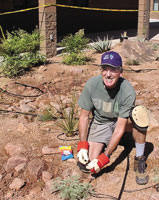
John Jacobsen, of the High Country Xeriscape Council, installing drip lines. "
In the Rim country residents are discovering an added bonus to this new style of gardening in the manner of water conservation.
As reports of the possibility of a continuing drought trickle into our consciousness, it becomes apparent that westerners cannot continue to pour 70 percent of our potable water supply onto landscapes. Living in the arid, high desert, with its uncertain water supply, challenges home gardeners and professional landscapers alike to conserve water used out of doors around homes and businesses.
As gardeners begin to consider the concept of gardening appropriately for the climate zone in which they live, a new terminology for this style emerges. "Xeriscape" is a word we are beginning to see regularly, the root-word "xeros," being Greek, means "dry." A xerophilous plant is one that grows in dry regions, and most of the native plants from the piñon-juniper belt in which we live, fit that description.
Xeriscape is water conservation through creative landscaping. Gardening styles, which utilize xeric techniques, offer rewards for all gardeners, hobbyists and professionals alike.
The low water-use garden will support a broad range of plants and can be a haven for wildlife, attracting songbirds and small animals such as lizards, chipmunks and squirrels. Foliage can be lush, and flowers plentiful. Xeric maintenance is minimal, giving us more time to enjoy the fruits of our labor. The only thing missing in a xeric-based landscape is the use of inordinate or inappropriate amounts of water
Creating a low water-use landscape is simple and uses traditional, good gardening techniques. The basic concept of Xeriscape is "nature- scape," gardening with Mother Nature, instead of against her.
IN THE ZONE
Create zones for water use. Use those plants that require the most water in the coolest or shadiest areas, as on the north or east side of your home. Don't mix plants with different watering needs.
Establish lawn areas only where there is no alternative. According to the experts, lawns are resource wasters. They require large quantities of water, fertilizer, weed killers and pesticides, not to mention the energy and noise pollution involved in keeping them mowed.
How about considering a lovely herbaceous flowering or aromatic low-growing ground cover instead? If you must have turf, try Buffalo Grass (buchloe dactyloides) which is un-thirsty, pest resistant, and requires minimal mowing.
Before you begin to plant, improve the soil by adding organic material like compost to help the soil hold the water you do use. Added bonus: when using hardy native plants, just loosen the soil, many don't like soil that is too rich.
Choose from the wide variety of native and low water-use plants now available.
Design efficient water systems utilizing drip technology and create ways to capture rain and snow runoff.
Use mulch. Mulches are soil coverings that minimize evaporation, keep soil cool and moist, reduce weed growth, slow erosion and help capture rainwater. Start a compost pile. The end result will feed your soil while you save on your trash bill.
Properly maintain your garden. Remove weeds, use fertilizers thriftily, and quickly eradicate pests before they become a problem.
The first concept of Xeriscape is to create zones for water use.
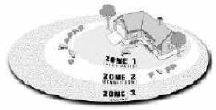
Begin with the water zone nearest your house. This zone can serve as a mini-oasis, utilizing the highest water-use plants in the landscape. The shady east and north sides of a building are good places for foundation plantings. The areas shaded by adjacent structures, such as carports and patio roofs can be included in this zone, utilizing runoff from rooflines and downspouts. Usually drives, walkways, planter beds and patios interrupt the planting areas in this zone, making it the smallest as far as square footage is concerned. A small turf area for children or pets would be located in this zone.
The second zone serves as a transition zone, blending the lush area with the dry area of your landscape. The plants for this zone will range from moderate to low water-use, and should require little supplemental watering (once a week or less) once established.
The third zone is the arid zone. This is a great place to include the native vegetation that occurs naturally in this area. The plants chosen for this area should require no supplemental water once established. This area would be located the farthest from the house and away from high traffic areas.
Autumn is a good time to begin to assess the present landscape, design changes to be made and work on those changes while the weather is cool and comfortable. Take note of plants that have suffered during the summer, and determine whether or not to keep them. Visit local nurseries, arboretums, order plant catalogs or look at online websites to find new environmentally friendly plants to replace those that are not appropriate for this area. Work on making structural changes or "hard-scape," which might include laying a walkway, setting large rocks in place, building a dry-stone wall, or reducing your turf area.
Control perennial weeds, but take into account that plants previously considered "weeds," might be native wildflowers that could be incorporated into a new, natural gardening plan.
Permeable surfaces allow the absorption of water and snowmelt to ooze back into the soil. Assess present hard surface drives and walks to see which way they drain, and utilize the runoff for a possible flower bed.
Design a water system, incorporating water harvesting rainwater, and a gray water re-use system. Pamphlets on gray water are available at the Town of Payson Water Department.
The most efficient way to conserve water out of doors is to install a drip system which delivers water directly to plant roots, thereby cutting down on evaporation and run-off. "RAINDRIP" has an excellent booklet on how to install a drip irrigation system and it's free and available at nurseries. Multi-emitter fittings can replace old-style lawn sprinkler heads. Drip components are not expensive, and the cost can be recovered in a few months' savings on your water bill.
Gardeners anxious to get started planting new plants might identify an area away from the house that will become an arid zone. Select plants that are very low water-use, but give them what they need to become established.
Fall is an excellent time to plant because cooler temperatures put less stress on plants. Winter precipitation will allow root growth, so the plant will be able to burst forth with new growth in the spring.
Sow wildflower and native grass seed after the first frost in meadows and swales.
The new High Country Xeriscape Demonstration Garden in the main courtyard at the GCC campus is open to the public and offers a firsthand look at low water-use plants, water-harvesting techniques and permeable surfaces. The information kiosk has educational materials to take home.
August in the Rim Country Garden ![]()
 As monsoon rains bring respite from the heat and the parched ground soaks up much needed moisture, it's time to think about summer maintenance. All plants are revived by rainfall, harvesting moisture from leaves and needles as well as from the soil. Everything is greener, dust is removed from plants, and nitrogen in the rainwater feeds the capillaries of the leaves and roots
As monsoon rains bring respite from the heat and the parched ground soaks up much needed moisture, it's time to think about summer maintenance. All plants are revived by rainfall, harvesting moisture from leaves and needles as well as from the soil. Everything is greener, dust is removed from plants, and nitrogen in the rainwater feeds the capillaries of the leaves and roots
Changes in precipitation and temperature bring other changes in the garden. Drip systems must be adjusted or turned off, as Mother Nature has taken on the watering chores. Weeds should be removed as soon as they are big enough to pull to prevent seeding and re-growth next year. Garden plants must be inspected nearly every day to watch for signs of white fly and powdery mildew.
Pauline Rodriquez roams her large meandering garden armed with a bottle of homemade spray intended to discourage pests without damaging the environment.
She is concerned about the widespread use of pesticides and herbicides, and wonders why there is such a scarcity of bumble bees and butterflies this year. Wandering the pathways of this verdant landscape, the visitor discovers evidence of conservation and concern for the environment at every turn.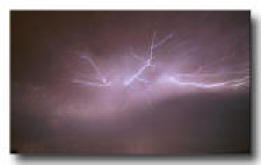
Trellises and arbors are constructed of tree trimmings, and opalescent unused compact discs twist and sparkle in the breeze to keep birds away from fruit. A wide variety of cast-offs, such as a golf bag, a bicycle basket and a child's play wheelbarrow are parked in the garden and pressed into use as planters. In order to conserve water, Mrs. Rodriquez has begun removing favorite plants from the ground and planting them in pots. The pots are then grouped in large plastic boxes, such as those used for under-bed storage. Plants are watered from the top but are able to reabsorb the water, which runs through the pot into the large drip pan. These oversized saucers also catch rainwater for absorption later.
Plants that are still growing in the ground are heavily mulched to hold in moisture. Mulch is made from well-rotted horse manure and garden sweepings.
For regular organic feedings, Rodriquez makes "tea" from alfalfa steeped in water. To rid the garden of unwanted ants, she says boric acid does the trick. To get rid of whitefly, hang strips of florescent yellow poster-board coated with Vaseline. And what to do about that powdery mildew? Try 2-3 tablespoons of baking soda dissolved in about a quart of water. Add a teaspoon of dish detergent, shake and spray.
The gentle care taken for all life forms in this garden pays off in seedlings and rooted cuttings of everything from herbs to roses to small trees that Pauline features in her annual plant sale, sometime in April. Roses are her favorite plants because of their fragrance and wide variety of bloom types. Even though they take the most work, to her they offer the greatest reward, and dozens are growing in pots just waiting for next April.
This month in Rim country gardens, it is time to:
Plant the fall garden by setting out cabbage and celery plants, and seeds for beets, broccoli, Brussels sprouts, chard, kohlrabi, lettuce, radishes, spinach, turnips and rutabagas.
Feed trees and shrubs with an all-purpose tree and shrub fertilizer, or side-dress by digging in rotted compost around the drip-line.
Maintain flowers dead-heading annual flowers to coax another month or so of bloom, cut back summer blooming perennials to the basal rosette as they finish blooming. Lavender, yarrow, cockscomb, amaranth, goldenrod, roses and grass seed heads can be dried for bouquets. Hang bunches up side down in a dark, well-ventilated spot. Then thoroughly dry and store wrapped in newspaper in a covered box until needed.
Low care, no care grasses a water-wise alternative ![]()
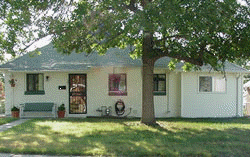
Grasses are at the base of the land food chain. They offer us food and erosion control, and even have served as status symbols at various times in history.
Grasses cover the earth, are among some of the oldest plants we know, and have provided the opportunity for mankind to progress to the 21st century.
Unfortunately, lush, green lawns, grown for no purpose other than to surround a home, do not fulfill any of the above conditions. They are labor, water and chemical intensive, and tend to pollute the environment more than protect or restore it. An average lawn-centered landscape uses 40 to 60 percent of the total water flowing through a residential water meter, and in our dry climate, roughly 70 percent of that water is evaporated into the air. Lawns often require fertilization and pesticides to keep them green, both of which can have a negative impact on our water table and water treatment process. A mower is necessary to keep the lawn manicured. It typically uses electricity or gasoline and human energy, and causes noise pollution. A lawn can become a very expensive luxury, not only for the individual homeowner, but also the community. Small plots of grass do have their place, offering a soft surface for children to play or pets to frolic. Large, manicured turf areas are best managed by parks, where, in many cases, grassy areas are watered with re-used effluent, and large numbers of people have access to the areas.
If grass is a necessity in the high country home garden, there are a few varieties that love our clay, alkaline soils, do well on very little water, require no fertilization, and mowing only once or twice a season to keep them tidy.
Blue Grama Grass (Bouteloua gracilis), is a high plains native, warm season, very drought tolerant lawn grass. It is fine-textured, forms sod, is easy to establish, cold hardy and disease free. It can be sown anytime up to two months before the first fall frost, and will fill out well in the first season.
Left unmowed, Blue Grama will form bunches that will be 1 to 1 1/2 feet high with seed heads. About 3-4 pounds of seed is sufficient for 1000 square feet.
 |
Blue Grama Grass |
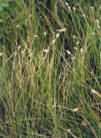
|
Buffalo Grass |
Buffalo grass (Buchloe dactyloides) is a very low growing grass that only reaches 4-6 inches in height. It's durable sage-green color, drought hardiness, resistance to diseases and pests make it an excellent choice for necessary lawn areas and meadows. Buffalo grass is now available as sod, in flats as plugs and by the pound as seed. A warm- season grass, it colors to beige over the winter but greens up in the late spring. It also will go dormant in the summer if extremely hot and dry, but bounces back beautifully when the monsoons come.
Other alternative lawn grasses are available through nurseries and catalogs. Based on the average amount of annual rainfall, requirements for cool or warm season grasses, or location needs, a single grass or combination of alternative "unthirsty" grasses can be chosen to meet almost any need.
Xeriscape a water-wise alternative ![]()
The town water department is about to release a 200-plus page groundwater management status report, and it's not good news. While water production is up by 1,313 gallons per minute to a total of 3,433 since 1997, consumption is also up.
Payson water customers are using 38 percent more water than they did four years ago, much of it reflected in an unprecedented increase in consumption during the winter months.
According to town hydrologist Mike Ploughe, who authored the study, current rates of consumption will significantly impact the number of people the town can provide with water.
It would almost be better, Public Works Director Buzz Walker said, if Payson had a surface lake that is slowly drying up. "That might help people visualize the water situation." Lacking such a reminder, the town council will consider several recommendations, including raising water rates until we finally get the message.
Since outdoor watering accounts for about 40 percent of all water use, and an established, properly maintained xeriscape takes only about one-third the water of a traditional landscape, xeriscaping is an alternative that can make a huge difference.
Ploughe says the town is doing all it can to increase the water supply, including rehabilitating existing wells and pursuing new water on federal land.
But new water is expensive, and the costs are passed on to taxpayers and water customers. Xeriscaping, while not free, can go a long way toward reducing consumption and keeping our future on track.
Plant selection, placement key to water-wise landscaping ![]()
Grouping plants with similar water requirements together will simplify the design of your low-water-use irrigation system. This technique also reinforces the concept of planting in zones ? placing those plants with the 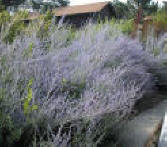 highest water needs nearest the house, those with moderate water needs in the transition zone, and low-water-use plants in the arid zone, farthest from the house.
highest water needs nearest the house, those with moderate water needs in the transition zone, and low-water-use plants in the arid zone, farthest from the house.
If you are a vegetable gardener, or enjoy fruit trees, consider placing these plantings where they can benefit from roof run-off. Other high-water-use plants will thrive on the north and east sides of your house, where shade from the hot summer sun will keep the roots cool and moist.
Most flowering plants require about six hours of sunshine daily for the best blooms, but columbine, coral-bells, Parry's primrose, and some coneflowers are a few exceptions.
Ferns are very shade tolerant, as are members of the honeysuckle family and Virginia creeper, a vine that displays brilliant red foliage in the fall. Among the many shrubs that will tolerate partial shade are most members of the cotoneaster family, the barberry family, many junipers, the sumacs, wild roses and Oregon grape. These plants offer a wide range of sizes, textures, colors, berries, and choices between evergreen and deciduous.
Trees that are well suited to planting on the north and east are maples and oaks that naturally thrive in climate zones a little wetter than our own.
The transition zone, or mid-range area of your yard, is a good place to landscape with low- to moderate-water use plants. These areas usually receive sunlight most of the day, so flower families such as yarrow, butterfly bush, the asters, chocolate flower, poppies, many penstemons, and coreopsis do very well here. A limited turf area fits into this zone also.
Try one of the native fescues, or, for a more evenly textured lawn, a low-water, low-maintenance turf of buffalo grass might fit the bill. Our sun-loving shrubs include the large family of artemisias, of which sagebrush is an important member. Others shrubs such as the chokecherries, spirea and barberries offer interesting textures, structure and berries or fruits for birds and small animals.
This is also the place to plant those specimen trees such as blue spruce, Douglas fir and Arizona ash. Plants that will thrive in the arid zone are the most drought-tolerant once established. This is the place to put all your favorite natives such as manzanita, native juniper, Arizona cypress, pinion pine, and a large number of oak species. Mountain mahogany, New Mexico privet, fairy duster, the full range of yucca plants, cliff rose and apache plume are all at home here.
Plants that will thrive in the arid zone are the most drought-tolerant once established. This is the place to put all your favorite natives such as manzanita, native juniper, Arizona cypress, pinion pine, and a large number of oak species. Mountain mahogany, New Mexico privet, fairy duster, the full range of yucca plants, cliff rose and apache plume are all at home here.
If you have established native trees such as pines, oaks and junipers, choose plants to landscape around their bases that will not require more water than the tree can tolerate. Plant a minimum of four to six feet away from the tree trunk, using varieties that will survive on natural precipitation after the first season. Native fescue and ornamental fountain grass, bear grass, rhus trilobata, ceanothus, and many members of the sedum family, iris and daffodils are low-water-use companions.
Consider a living Christmas tree this year ![]()
Trimming trees and clearing brush now, gives home gardeners a special opportunity for holiday decorating. Wreaths and garlands made of juniper, pine and manzanita are beautiful, fragrant and unique, and they offer a way to use these materials before finally putting them through the shredder or hauling them off to the brush pit. Instructions for making wreaths and garlands with natural materials will be found on www.sunset.com and www.marthastewart. com. 
Those who will be decorating a Christmas tree may want to consider a living Christmas tree, roots intact. Not only will this solve the annual problem of finding a tree, but also will bring many years of enjoyment growing on the property, perhaps replacing trees recently lost to drought or pests.
For nearly the same price as a tall cut noble fir, the homeowner can purchase a native pine, spruce or juniper.
Before shopping for a living tree, decide where it will be displayed inside, and where it will be planted outside. Take into account the mature size of the tree, allowing plenty of room for spread, and the normal water requirement, choosing a drought tolerant tree over a thirsty type. If space for planting out-of-doors isn't a possibility, consider a slow-growing specimen for container growing on the deck or patio.
When shopping for a living tree, be aware that the nursery industry markets two different types of tree: the sheared, perfectly shaped tapered trees grown for ornamental use; and landscape-grade trees that receive little special attention. Landscape trees tend to be less expensive than the sheared variety, but might be a little rangy and less perfectly shaped. A discussion with an experienced nursery person will reveal the ideal growing conditions for your living tree, but a little research prior to the visit is helpful. Choose an evergreen suited to personal taste in Christmas trees, but that also fits the Rim country low-water use gardening style.
Purchase a tree from a reliable nursery source as opposed to a tree lot, and check to make sure the root ball is intact and has been well cared for. Condition the live tree for bringing indoors by storing it in a cold garage, shed, or under the patio roof for a week or so. Place root ball in large pot or bucket with good drainage and keep roots evenly moist while indoors. It's best to limit the inside stay of a living tree to 10 days or less. Check the root ball every other day and water when the top 2 or 3 inches of soil is dry.
Some excellent choices for the water-wise gardener in the Rim country are: Austrian Black Pine, Scotch Pine, Ponderosa, any member of the Juniper family, and Deodora Cedar. Arizona Cypress, our most drought-resistant tree, has a nice shape, but an unpleasant fragrance. It does, however, lend itself well to a pot on the front porch, covered with lights.
Once the holidays have passed, place the tree outside in a sheltered spot, like under a porch roof or on the south side of the house where the root ball won't freeze, and water when needed. When fully acclimated in 10 days or so, prepare the planting hole, which should be slightly deeper than the root ball, and twice as wide. Carefully remove the tree from the container, loosen the roots if necessary, and spread them into the hole, filling in soft soil. Mix in about 1/3 compost with 2/3 soil, and tamp lightly, leaving a shallow well as wide as the drip line. Fill the well with water and let seep into the root zone. As the soil settles, add more, but leave a shallow well to collect snow and water, and layer in about 3-4 inches of mulch to help hold in moisture and discourage weeds.
Since most conifers are relatively slow-growing, it is possible to grow the tree in a container and bring it indoors for several years to come. Container grown trees must be watered year-round, when the top 2 inches of soil is dry. Water until the water trickles out of the drain holes. Before new growth begins in the spring, gently tug the root ball out of the container and check the roots. If they are starting to circle the inside of the container, nip them back with sharp pruning shears, rough up the root ball, and plant in a larger pot. To prevent the roots from overheating in the summer, always remove the tree from the black plastic nursery pot, and plant in terra cotta, wood, or even sink the plastic container into the ground. Overheated soil will kill the roots, and eventually the tree.
A peaceful and joyous holiday season to you all!
Water Saving Strategies ![]()
Amend Soil
Soil is essentially a bunch of mineral particles of different sizes. If most of the particles are large (sand), water drains through rapidly. If most of the particles are small (clay), the water will penetrate the soil much more slowly. The solution for either problem is the same: organic matter. Organic matter, in the form of compost, chopped up leaves or composted manure will improve the texture and water-holding capacity of your soil. Add at least an inch of compost each year.
Water the roots
Drip irrigation ensures that up to 90 percent of the water you apply to your garden is actually available to your plants. Sprinklers can claim only a 40 to 50 percent efficiency. Drip irrigation minimizes evaporation loss and keeps the areas between plants dry, which also helps limit weed growth.
Use mulch to retain water and reduce evaporation
A six to eight-inch layer of organic mulch can cut water needs in half by smothering weeds and reducing evaporation. Organic mulches retain some water and increase the humidity level around the plants.
Organic mulches includes: 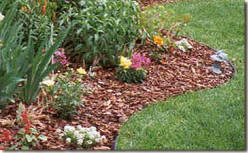
Chopped or shredded leaves
Straw
Compost
Shredded newspaper
Grass clippings
Rotted hay
free water
Rainwater is the best choice for your plants. It's clear, unchlorinated and free.
Before you plant - PLAN
By planning your garden before you plant, you can take advantage of the characteristics of your site, such as sun, shade, wind and soil. Group plants with similar water needs. Also consider how your plants will get the water they need. Will you need to carry water to demanding plants in a remote corner of your yard? Planning will save you time and energy down the road.
Choose plants carefully
A plant that's satisfied getting most of the water it needs from natural rainfall will require a lot less work from you. For water-thrifty perennials, choose varieties that are native to your area (or a region with a similar climate). These plants will be naturally adapted for your local climate and soils.
Take care of your plants
Healthy plants need less water, fertilizer and pest controls than stressed plants. By keeping on top of tasks like weeding, thinning, pruning and monitoring pests, you'll be able to ease off on watering.
Creating Your Water-Wise Garden
![]()
Choosing the right plants, such as lavender and salvia greggii, installing a drip irrigation system, and using plenty of mulch insures a successful low water use landscape.
Water-wise gardeners can learn how to maintain a beautiful landscape and save water too. The secret is to choose the right plants, install a water saving and efficient method of irrigation, and find ways to make the water stretch as far as possible. Municipal water departments and water companies throughout much of the west estimate that roughly 70% of the water sold to homes and businesses is used out of doors. In the rim country, the ground water supply is under pressure from increasing population and decreasing annual precipitation. Water conservation may become a crucial issue to the quality of life, and may make the difference between a thriving, growing community or a declining one.
Every year the quantity of use increases four fold between March and July. As the growing season begins and visitors flock to the high country, everyone uses more water. Motels use water for showers, room cleaning and Jacuzzis. Restaurants serve more water, and use more for clean up. Gardeners and groundskeepers start pouring water on trees, grass, flowerbeds, golf courses and vegetable gardens.
Gardening is the #1 national pastime, exceeding reading, watching sports and travel. The garden industry, which includes landscapers, designers, garden products and nursery centers is a multi-billion dollar industry. At the heart of this huge industry, is earth’s most precious commodity: water. Gardeners in arid regions are learning new techniques and rediscovering ancient secrets for harvesting water, using it more efficiently, reusing it, and eliminating waste.
Xeriscape is a term which applies to the science of water conservation in the home or business landscape setting. The concept began in Colorado in the 1980’s when Denver was suffering from drought and a growing population. There are seven basic principles which help gardeners adapt to a water conserving form of garden management. These principles can be applied to any form of gardening, and any size of landscaped area. Commercial properties as well as private homes will benefit from Xeriscape techniques because those with the largest water bills will realize the greatest savings.
Planning and Design. Whether starting from scratch or working with an existing landscape, create zones for water use. Grouping plants with similar water needs will make watering more efficient. Use plants that require the most water in the coolest or shadiest areas, as on the north or east side of a building. For ideas, drive around the community and see how others have landscaped with rocks, shrubs and trees. Visit the demonstration garden at GCCC.
Establish practical lawn areas. According to the experts, lawns are resource wasters. They require large quantities of water, fertilizer, weed killers and pesticides, not to mention the energy and noise pollution involved to keep them mowed. Consider an herbaceous flowering or aromatic low growing ground cover instead. If a small amount of turf is required, try Buffalo Grass (buchloe dactyloides) which is reputed to be un-thirsty, pest resistant, and requires minimal mowing.
Design efficient water systems utilizing soaker hoses or drip technology and create ways to harvest rain and snow runoff. Free informational brochures available wherever drip system components are sold. Utilize roof runoff by capturing rainwater in barrels on downspouts. Slant drives, and patios to direct runoff onto flower or vegetable beds. Pick up a booklet on water harvesting at the garden kiosk at GCCC or you can read some rainwater harvesting information online at http://www.rainwatertanksdirect.com.au." The Town of Payson water department has information on gray water systems.
Condition the soil: Improve the soil by adding organic material like compost to help the soil hold the water you do use. Loosen soil around the planting area , and check for good drainage.
Use mulch. Mulches keep soil cool and moist, help prevent weeds and help capture rain water. In addition, organic mulches encourage earthworms, and add nutrients to the soil.
Choose plants that have minimal water requirements. In this climate zone (USDA 5-7, depending on location) there are dozens of trees, shrubs, groundcovers and flower species that will thrive and bloom year after year with little or no water once established. A plant list is available at this web site, and High Country Gardens in Santa Fe 800 925-9387 will send a catalog of colorful perennials free of charge. Plant Fair Nursery has a good selection of low water use natives, which can be planted now.
Appropriate maintenance. Remove weeds, use fertilizers sparingly, and quickly eradicate pests before they become a problem. Learn the appropriate season to prune shrubs or cut back perennials. Most native plants do not need pruning, and are more attractive if left to grow into their natural shape. Excessive pruning stresses a plant, forces it to require more water, and is usually unattractive.
The Wildflower Garden ![]()
Have you ever wished you could find something that would grow with little (if any) water, give you lots of interesting color and texture over a long period of time, attract birds and other small animals, and required little (if any) attention? Sounds too good to be true, doesn’t it. Guess what! It is good, and it is true, if you’re willing to do the preparation work, and choose the right seed! How about trying a wildflower meadow mix for your property border, large central bed, driveway edges or controlled hillside? 
Our native wildflowers and grasses re-seed themselves in the late summer and fall, as the annuals seed and die back, and new seedlings start to sprout during the late winter. The perennials often die back to the ground in the winter, but the roots carry over, and new plants can be seen breaking ground in early spring. If you want to try planting a native wildflower and/or grass mix, and you don’t want to wait until next fall, NOW is the perfect time to get it planted, and a little attention paid to detail at the beginning will yield optimum results later on.
While searching for the right combination of seeds, get the area prepared. Mow back any existing grasses or weeds that are more than 6 inches high. Rake the area well to break up the surface of the soil. Broadcast the seed at the prescribed amount for what you are planting. Cover seed with 1/4” mix of compost and sand. Mulch immediately with a light layer of mulch. Mulching holds in moisture, adds nutrients, and keeps weeds at bay. Don’t use compacted material, or anything too heavy because the little seedlings will need to get through it.
Now, for the hard part! Seedbeds must be kept damp (which is one of the reasons why you need to plant in the early spring). Give a good sprinkling twice a day for the first three weeks, and once a day for the next three weeks. After the initial 6 weeks, give a good soaking once a week or so for another month, and finally twice a month if needed until frost. Obviously, this schedule is for extremely dry conditions. You have to be the judge, if your plants look healthy, watering times can be delayed stretched out. Once established, your wildflower borders will basically take care of themselves, with just a good mowing and mulching in the late autumn. 
The key to success is to choose a combination of flowers and grasses that are hardy, drought resistant, and heat tolerant. Plants of the Southwest has two wildflower mixes that are suitable (plus many individual varieties, of course. The High Plains Pinion-Juniper Mix #P4021 is rated for 4,000 to 8,000 feet in altitude and 15” (+/- 40%) rainfall! This colorful and sturdy mix includes blue flax, Rocky Mountain penstemon, pale evening primrose, poppies, chocolate flower, bachelor buttons, daisies, firewheel, yellow coneflower, Mexican hat, coreopsis, skyrocket, gayfeather and prairie aster. P4005 High Desert Mix will flourish at elevations from 3,000 feet to 6,000 feet, with hot summers, cold winters and 5-18” of rainfall per year. This combination includes sand verbena, pruple aster, coreopsis, New Mexico lupine, verbena, Mojave bluebells, purple prairie clover, desert marigold, sand penstemon, blue flax, evening primrose, coneflowers and gaillardia. Plants of the Southwest can be contacted by calling 1-800-788-SEED (7333) or www.plants of the southwest.com or if you’d like to send them an e-mail: contact@plantsofthesouthwest.com.
Forewarned is Forearmed ![]()
Precipitation amounts this winter have been disappointing in the high country, and evidence of last year's beetle activity is everywhere. Joe Nation checks inventory of drip system components at Ace Hardware in preparation for spring. 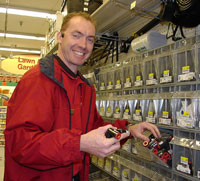
Facing another year of continuing drought can be a nightmare for gardeners unless preparations for garden survival start now. The balance between exercising one's right to garden as she pleases, doing what is right for the environment, and remaining mindful of uncertain water supplies and possible water use restrictions is a delicate one, at best.
March is an excellent time to make decisions about what changes, if any can, and should be made.
On most Rim country properties, cultivated areas are intermingled with native shrubs and trees, and many lots have dense thickets of different types of native vegetation. According to the experts, we can help our native trees withstand the rigors of drought by giving them more space.
When trees are too crowded, or the area under them is thick with lower growing vegetation, the trees have to compete for water and nutrients. When water is scarce, that competition stresses the tree, weakening it and making it more susceptible to pest infestation. Pruning dead or damaged branches is also beneficial to tree health.
A new product, Vita Planta 2000, is a castor-oil sulfonate that helps trees retain moisture, so they are better able to fight off beetle attacks. It is an organic substance, and totally non-toxic. Applied as a foliar spray, it also wets the ground around the base of the tree. Available from Rim country applicators who are equipped to spray the professional strength formula, Vita Planta can also be purchased for home use by calling (928) 474-2142.
For additional information log on to www.vitaproducts.com.
For help in clearing overgrown brush and thinning trees, contact RPAP at (928) 468-8694. Local fire departments also have staff who can make property assessments.
The first step is to assess the water needs of each plant in the garden. Those that require large amounts of water can be moved closer to the house, where reclaimed water from cooking, dishwashing, etc., can easily be used to water them. When selecting new plants or seed from the nursery, select plant types and varieties that are drought tolerant. Improvement of the moisture holding capabilities of the soil and minimizing evaporation are integral to low water use gardening. Working plenty of well rotted compost into the planting hole, and layering 3-4 inches of organic mulch around the base of the plant will protect roots from drying out, and keep the soil cool. As the mulch breaks down, it becomes the compost for next year.
Install drip irrigation systems with emitters for each plant, or laser-drilled drip hose for groundcovers. Micro sprayers and misters are not only prohibited by the Payson water ordnance, but should be avoided due to the high evaporation rate, and their inability to deliver water to the root zone of the plant. Automatic systems can be outfitted with a water miser to prevent turning on during rainfall.
Rethinking the design of vegetable gardening, from square beds with raised rows to a meandering and terraced landscape surrounding the house will allow the home gardener to use rainwater runoff in an efficient way.
Captured rain and snow melt in barrels placed under downspouts can be used at a later date, by hand dipping, or installing a spigot and hose connection at the bottom of the barrel. Design a recycling system now for using clean sink and shower water.
 March is the month to plant seeds of cool season vegetables such as beets, carrots and turnips as well as lettuce, onions, and peas and can be sown directly into the ground. Be sure to dig in a few inches of well-rotted manure or compost before planting. Many varieties of drought tolerant wildflowers will germinate in cold wet soil and can be scattered now. Try lupine, annual coreopsis, rudibeckia, mallow, California poppy and native asters.
March is the month to plant seeds of cool season vegetables such as beets, carrots and turnips as well as lettuce, onions, and peas and can be sown directly into the ground. Be sure to dig in a few inches of well-rotted manure or compost before planting. Many varieties of drought tolerant wildflowers will germinate in cold wet soil and can be scattered now. Try lupine, annual coreopsis, rudibeckia, mallow, California poppy and native asters. 
Prune perennial plants now for a spring flush of growth, and set out bare root perennials. To encourage naturalization, feed spring bulbs with a general all-purpose fertilizer as soon as flower shoots emerge. Once the foliage turns brown, remove it and feed again.
Spring Might Promise Good Monsoon
"April showers bring May flowers" and by looking around our Rim communities that seems to be true, at least for this year.

Longtime residents remember spring rains, cooler temperatures and higher humidity than we have experienced the past few years, so this year's spring weather gives hope for a productive monsoon season as well. All sorts of native wildflowers are in bloom now, from the tall bright red penstemon to the low mounding lavender sand verbena, with our glorious orange California poppies filling the space between.
The key to lush early spring flowering lies in planning ahead, by planting seeds in the fall or winter, or buying flowering shrubs and perennials in the spring and summer when they become available.
A visit to a nursery now will provide the opportunity to buy plants that will continue to bloom for a while, but will burst forth next year at this time.
Flowering shrubs add interest to the landscape, by producing blooms, seeds and occasionally fruit. Some, such as forsythia, bloom early on bare branches, and others have foliage that will change color with the advancing seasons. Deciduous plants lose their leaves in the winter, adding a structural element also. The new Randall Park which features the Original Pine Library is nearing completion and is being planted with native shrubs and others with historical significance. The hard working "Take Pride in Pine" volunteers have researched which plants will do well with little maintenance and upkeep after they are established. The goal in developing the little park is to give residents and visitors a place to pause and relax and enjoy a bit of Pine history.
Forsythia, lilac (Syringa), Cliff rose, (Cownaia Mexicana), Russian sage (Perovskia Atripicifolia) and three leaf sumac (RhusTtrilobata) are among the plants chosen for the project. These plants are known to be tough, drought resistant, and some have tremendous historical significance. Early settlers often brought cuttings of lilacs and forsythia from gardens elsewhere.
Gardening Principles
The gardening principles demonstrated in the small public space serve as a sound example for all Rim country gardens. Volunteers have grouped plants with similar water needs together, used rocks and gravel as mulch, and installed a drip system that will be turned off and on manually as the need arises. The park has been developed as a public place for visitors to rest and relax and eat their lunch in the shade provided by three canopies, which are placed over picnic tables.
Other tough shrubs that will thrive in our Rim country environment, and that are available commercially include: Leadplant, Amorpha species; Sagebrush, Artemesia filifolia; Saltbush, Atriplex; Mountain Mahogany, Cercocarpus; Rabbitbrush, Chrysothamus; Cliff rose, Cowania mexicana; Apache plume, fallugia paradoxa, New Mexico privet, Forestiera neomexicana; Hesperaloe; Buffaloberry, Shepherdia argentea; Yucca; and Snowberry, Symphoricarpos albus.
Tending to a few maintenance chores now will prevent problems later on.
Pests: Hand pick and destroy grape leaf skeletonizers, and use insecticidal soap on spider mites that may be attacking evergreens. Keep an eye out for borers, pine tip moth and bark beetle.
Feed: Side dress roses with rich compost throughout the blooming season.
Plant: Vegetable gardens, heat-loving annuals, perennial flowers.
Irrigate: Check drip systems weekly for leaks or malfunctions. Monitor water needs of plants before turning system on. Mulch, mulch, mulch! Mulching discourages weeds, holds in moisture, keeps roots cool.
Keeping Poinsettias Alive Past Christmas ![]()
Among the most popular gifts for the holidays are indoor seasonal plants. Poinsettias add bright natural colors and scents to holiday décor. Making the colors last, and keeping the plant alive for enjoyment during seasons to come can challenge even those with the greenest of thumbs.
|
|
Most plants offered by retailers for seasonal giving are rushed by climate controlled carrier from greenhouses in temperate climates to grocers, discount houses and nurseries with disparate display conditions. Coming from a warm, moist place to a dry, drafty spot will cause stresses that may not show up for several days or weeks to a plant.
Plants prepared for seasonal use may also have been forced in a greenhouse resulting in a poorly developed root system. These plants are also fed so vigorously that the forced growth could result in the plant having no more energy to survive beyond a few weeks.
A poinsettia can be nurtured into a lovely year-round house and patio plant and even coaxed into blooming next winter.
Until the 1920s, poinsettias were grown in greenhouses and sold only as cut flowers, imported from Mexico and South America.
In 1925, Joel Poinsett who was the U.S. Ambassador to Mexico, sent home cuttings of Euphorbia pulcherrima. These plants had been cultivated by the Aztecs long before Europeans arrived in the western hemisphere. Pulcherrima was used in midwinter celebrations and its colorful bracts were used to make dyes, while the milky latex sap was used to counteract fever. Although the plant is not poisonous, it is not edible and can cause gastric discomfort. It should be kept out of reach of pets and small children.
Prolonged bloom will result from making sure the plant has about six hours of indirect, natural daylight, but not direct sunlight. Plants must be kept out of cold drafts, away from excessive heat, in ideal temperatures of 65 to 70 F during the day, and 60 to 62 F at night.
Removing damaged or diseased leaves will keep a plant stronger. Keep soil moderately moist, watering thoroughly when it feels dry to the touch. Poinsettias should not be allowed to sit in water, and do not need to be fertilized while in bloom, but to promote new growth, apply a well balanced indoor plant food once a month after the holidays.
Poinsettias receiving south and east sun may be placed outside on a shaded patio during the summer months. According to the Colorado State University, it is possible to get these plants into bloom the following winter, but it is a complicated process, and must be strictly followed.
After a plant has passed its stage of usefulness, usually by late March or early April, remove the bracts and part of the stem. This cutting back can be done any time through mid-July, depending on the desired final size and shape of the plant. Leave three or four leaves on each remaining stem.
During late spring and early summer, move the plant to the next larger size pot. Use a well-drained potting medium, preferably heat pasteurized. Use any well-drained soil, such as a blend of equal parts sphagnum peat moss, vermiculite and/or perlite. Thoroughly mix 1 tablespoon of treble super-phosphate fertilizer (0-46-0) in each gallon of soil mix. Apply a slow release fertilizer to the soil surface.
If all this sounds like too much work, perhaps settling down with a cup of hot cocoa and a stack of new seed catalogs will suffice to keep the gardening demons at bay. Just in case the mailman isn't stuffing the mailbox with catalogs yet. www.highcountrygardens.com, (800) 925-9387 and Plants of the Southwest, www.plantsofthesouthwest.com, (800) 788-7333 are two reliable sources to contact for catalogs.
Western Native Seed, www.westernnativeseed.com or (719) 942-3935, which specializes in native plant seeds for the Rocky Mountains and Western Plains has an exceptional website, and also a print catalog.
Territorial Seed Company, www.territorialseed.com or (541) 942-9547 is an excellent source of flower, herb and vegetable seeds that do well in our hot day, cold night climate of summer.
Contact Wildseed Farms www.wildseedfarms.com or (800) 848-0078 for wildflower seeds and comprehensive information on how to grow them.
Garden maintenance for January is minimal, but pay attention to the weather.
MULCH: Mix some manure with straw or oak leaves and pine needles or wood chips and spread around the base of trees, shrubs and perennials. Winter rain and snow will break down these materials and feed the soil, while the bulk will protect roots from freezing and will hold in moisture.
WATER: Keep a garden journal and when Mother Nature has not provided rain or snow for 3 weeks, start checking soil moisture. When top three or four inches of soil are dry, use a soaker hose at mid-day to water trees and shrubs. Buy a moisture meter and rain gauge to gain accuracy as to how much water is really necessary.
PLANT: Visit a nursery and look at low water use plants with good "bones" to provide winter interest. If now is not the time to plant those selected, enter their names in a garden journal, for later reference.
copyright 2003© HCXCA
